News
The MiG-21 fighter jet: History & significance to the Indian Air Force
The MiG-21FL was the first of four major variants to serve with the IAF.
BHPian V.Narayan recently shared this with other enthusiasts.
Ode to the Mikoyan Gurevich MiG-21
IAF Day Flypast in October 2023, at Prayagraj, to be MiG-21’s last
The IAF has announced that the venerable MiG-21 will be retired in 2025 being replaced by the Tejas. The MiG-21 will participate in a public flypast one last time on 8th October 2023 at the 120 aircraft flypast to be held over Prayagraj.
Hopefully HAL can ramp up its production of Tejas quick enough. 2025 when it finally retires will mark 60 years in IAF service for this remarkable aircraft. Kudos to not just the pilots but more so to the engineers and ground crew who kept the machines flying.
The youngest MiG-21 in our inventory is around 35 years old at least. The only aircraft in a major Air Force of similar vintage, still in active service, that I can think of are – Boeing B-52, Tupolev Tu-16 Badger, Lockheed C-130, Tupolev Tu-95/142 Bear and the flying forever Antonov An-2 biplane. But of them all the MiG-21 is the only one which is a fast combat aircraft commonly called a fighter.
The essay below is meant to be a light reading dedicated to this most classic of fighters. I have not gone into technical details, design characteristics etc which would require a significant investment of time and effort.
The MiG-21 story:
The MiG-21 entered service in 1965 on a trial basis and from 1966 more substantially. It formed the backbone of our fighter fleet from circa 1970 to the mid-2000s till the growing number of Su-30MKIs started making themselves felt. It was license built in India from 1966 toc.1988.
As a design it remains a classic being the smallest airframe wrapped around a very powerful engine and fitted to 57 degree sweep back delta wings in turn married to tail wings. This gave rise to the classic design of the tailed delta. For speed, acceleration you need a delta wing. But in a tight turn it loses lift rapidly and needs dangerously high speeds while landing. The tail wings partially help solve for these. Most planes have tail wings so what's the big deal one may ask. But aerodynamics makes designing the right tail for a thin sharply swept back Mach 2.0 delta wing planform a challenge which the French could not solve with the Mirage III and the Americans with their Delta Dagger series, both contemporaries.
A leading Western test pilot who had flown the MiG-21 and other Western aircraft was once asked to compare the MiG-21, Dassault Mirage III and the English Electric Lightning. He dismissed the Lightning outright as pedestrian in anything but climb. The Mirage III he said was comparable and better for peacetime due to superior cockpit ergonomics that could imply fewer accidents in peace times. But in war he said he would bet on only the MiG-21 given its manoeuverability, climb rate, small cross section all of which would give a well-trained pilot the edge in combat. Given how dismissive Western media is /was of Soviet aircraft, due to ignorance and prejudice, this was a compliment to beat all compliments. {reference: Red Star Rising by Doug Richardson, Hamlyn Publications, 1988}
Mig-21FL:

The MiG-21FL was the first of four major variants to serve with the IAF. Here I am not including a handful of an earlier type that came in 1965. India's insistence led to the 23mm twin gun pack being added on the centreline to provide the pilot with a back up after he had fired both his heat seeking missiles. Powered by the 6175 kgf Tumanskii R-11 after burning turbojet this machine was a hotrod. In the hands of the North Vietnamese in the mid to late 1960s and early 1970s they played havoc with American fighters thanks to their manoeuverability and climb rates.

The MiG-21FL shone in the 1971 Indo-Pak war of Bangladesh's liberation. It was primarily responsible for putting the Dhaka airfield out of action with pin point bombing. Its most important mission was the rocket attack against the Governor's mansion in Dhaka while the East Pakistan leadership was holding a meeting there. The attack spooked them enough to eventually surrender.

By the time the hostilities came to an end, the IAF MiG-21FLs had claimed four PAF F-104A Starfighters, two PAF Shenyang F-6s {Chinese built MiG-19}, one PAF North American F-86 Sabre and one PAF Lockheed C-130 Hercules transport aircraft.
MiG-21 U:

The two-seat conversion trainer. Like many Russian machines built with limited interest in ergonomics. As you can see the rear seated instructor had no forward vision! A periscope was added to aid him. Not the best way to teach a pupil pilot how to land the fastest landing fighter in service. Landing speed ~250 kmph.
MiG-21M:


The MiG-21M was an upgraded fighter-bomber version of the earlier MiG-21FL described earlier. The externally mounted gunpack was integrated within the fuselage it could carry 4 air-to-air missiles instead of two and the internal fuel capacity was increased. Structure wise this was based on an entirely new airframe design. The Tumanskii R-11 engine continued which gave a slightly lower power loading due to the higher all up weight of the MiG-21M. This led this variant to move to ground attack roles in the 1980s onwards.
Pictured above is the very first MiG-21M assembled in India in February 1973.
MiG-21bis:


The third variant to fly with us was the last Soviet designed MiG-21 named MiG-21bis. In Russian that roughly translates to MiG-21 Plus. It was designed to be a fighter bomber. Powered by the much more powerful 7100 kgf Tumanskii R-25. This outstanding rugged engine could in emergencies develop an astounding 9900 kgf for 120 seconds to give a pilot a decisive power edge in combat.
MiG-21 Bison:



The final variant to serve with the IAF, and still flying, is the Indo-Russian upgrade, MiG-21Bison. This machine includes upgraded electronics, better navigation & and communication systems, the Russian Kopyo light weight multi-mode radar that can track 8 targets and attack 2 simultaneously, beyond visual range {BVR} air-to-air missiles, a helmet-mounted display & sights cued to the Russian R-73 heat seeking missiles, a redesigned HOTAS cockpit {Hands on Throttle and Stick} giving the pilot all key controls to fly and fight on his finger tips, a new electronic counter measures suite and a better windshield, among other improvements. Its crowning moment came when {then} Wing Commander Abhinandan shot down a Pakistani F-16 in 2019.
Length: 48 feet 3 inches excluding pitot boom
Wingspan: 23 feet 6 inches Wing area: 250 sq feet
Max takeoff weight: 9,800 kg
Powerplant: 1 × Tumanskii R-25-300 afterburning turbojet, 7100 kgf
Maximum speed (clean configuration): 2,175 km/h / Mach2.05 at 43,000 ft
1,300 km/h / M1.06 at sea level
Combat radius: ~350kms hi-hi-hi with two heat seeking air-to-air missiles and 800 litre drop-tank
Service ceiling: 57,400 feet
Initial climb rate at sea level: 45,000 feet per minute (225 metres per second)
Take-off run: 830 m (2,720 ft)
Guns: 1 × internal 23 mm twin GSh-23L autocannon with 200 rounds
Hardpoints: 5 (4 underwing + 1 ventral, reserved for fuel drop tanks), with provisions to carry combinations of:
4 × S-24 heavy air-to-ground rockets or 4× 57mm rocket pods or 4 heat seeking air-to-air missiles of various makes
or 2 × 500kg + 2 × 250kg bombs
This marvelous fighter is the most produced supersonic jet fighter ever with about 11,500 produced in USSR, China and India. It is also today the longest serving supersonic jet fighter in frontline inventory of a major Air Force - a testimony to the engineers of the IAF and our own botched decision making on selection of replacements and eternal delays with the Tejas. For about 35 years from the 1970s to the 2000s the MiG-21 remained the backbone of our Air Force. Its image in the public eye got tarnished due to the numerous crashes. The crashes IMHO were a function of inadequate training for rookie pilots given that for 30 years we did not have a proper advanced jet trainer and were using second grade spares purchased from East European countries to save costs.
Very soon the MiG-21 will fly off into history after having served our nation like no other aircraft.
Jai Hind.
Check out BHPian comments for more insights and information.











.jpeg)

_7.jpg)




